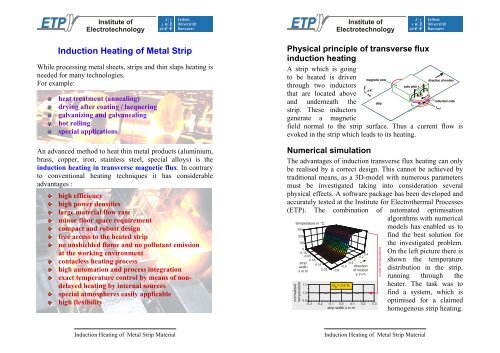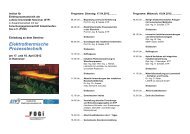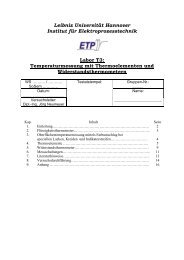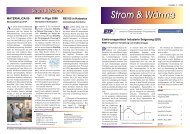Induction Heating of Metal Strip
Induction Heating of Metal Strip
Induction Heating of Metal Strip
Create successful ePaper yourself
Turn your PDF publications into a flip-book with our unique Google optimized e-Paper software.
Institute <strong>of</strong><br />
Electrotechnology<br />
<strong>Induction</strong> <strong>Heating</strong> <strong>of</strong> <strong>Metal</strong> <strong>Strip</strong><br />
While processing metal sheets, strips and thin slaps heating is<br />
needed for many technologies.<br />
For example:<br />
heat treatment (annealing)<br />
drying after coating / lacquering<br />
galvanizing and galvanealing<br />
hot rolling<br />
special applications<br />
An advanced method to heat thin metal products (aluminium,<br />
brass, copper, iron, stainless steel, special alloys) is the<br />
induction heating in transverse magnetic flux. In contrary<br />
to conventional heating techniques it has considerable<br />
advantages :<br />
high efficiency<br />
high power densities<br />
large material flow rate<br />
minor floor space requirement<br />
compact and robust design<br />
free access to the heated strip<br />
no unshielded flame and no pollutant emission<br />
at the working environment<br />
contacless heating process<br />
high automation and process integration<br />
exact temperature control by means <strong>of</strong> non-<br />
delayed heating by internal sources<br />
special atmospheres easily applicable<br />
high flexibility<br />
<strong>Induction</strong> <strong>Heating</strong> <strong>of</strong> <strong>Metal</strong> <strong>Strip</strong> Material<br />
Institute <strong>of</strong><br />
Electrotechnology<br />
Physical principle <strong>of</strong> transverse flux<br />
induction heating<br />
A strip which is going<br />
to be heated is driven<br />
through two inductors<br />
that are located above<br />
and underneath the<br />
strip. These inductors<br />
generate a magnetic<br />
z<br />
magnetic core<br />
y<br />
x<br />
field normal to the strip surface. Thus a current flow is<br />
evoked in the strip which leads to its heating.<br />
strip<br />
pole pitch t<br />
Numerical simulation<br />
The advantages <strong>of</strong> induction transverse flux heating can only<br />
be realised by a correct design. This cannot be achieved by<br />
traditional means, as a 3D-model with numerous parameters<br />
must be investigated taking into consideration several<br />
physical effects. A s<strong>of</strong>tware package has been developed and<br />
accurately tested at the Institute for Electrothermal Processes<br />
(ETP). The combination <strong>of</strong> automated optimisation<br />
temperature in °C<br />
300<br />
normalized<br />
temperature<br />
200<br />
100<br />
0<br />
-0.15<br />
-0.05<br />
strip<br />
width<br />
x in m<br />
1,1<br />
1,0<br />
0.05<br />
0.15<br />
0.25<br />
-0.4<br />
-0.6<br />
fz = 0,6 %<br />
h<br />
0.20.4<br />
0<br />
-0.2<br />
direction<br />
<strong>of</strong> motion<br />
y in m<br />
0,9<br />
-0,3 -0,2 -0,1 0,0 0,1 0,2 0,3<br />
strip width x in m<br />
outlet temperature<br />
I st<br />
algorithms with numerical<br />
models has enabled us to<br />
find the best solution for<br />
the investigated problem.<br />
On the left picture there is<br />
shown the temperature<br />
distribution in the strip,<br />
running through the<br />
heater. The task was to<br />
find a system, which is<br />
optimised for a claimed<br />
homogenous strip heating.<br />
<strong>Induction</strong> <strong>Heating</strong> <strong>of</strong> <strong>Metal</strong> <strong>Strip</strong> Material<br />
B<br />
direction <strong>of</strong> motion<br />
induction coils<br />
I Iind ind
Institute <strong>of</strong><br />
Electrotechnology<br />
New development <strong>of</strong> flexible heaters<br />
The industry request mainly high flexible, compact as well as<br />
robust installations, which provide a high availability.<br />
Therefore a new heater concept has been developed,<br />
overcoming the disadvantages <strong>of</strong> existing concepts. This<br />
variable-band-width induction coil system (VABID) is a one<br />
induction coil system<br />
consisting from<br />
several parts. This<br />
parts can be adjusted<br />
individual to adapt<br />
the system to the<br />
needs <strong>of</strong> modern<br />
productions with<br />
small lots.<br />
Different width <strong>of</strong><br />
the strip, variable<br />
strip thickness and<br />
several materials can<br />
be processed by the<br />
same induction coil<br />
in °C<br />
120<br />
110<br />
in °C<br />
110<br />
100<br />
in °C<br />
90<br />
80<br />
system. Furthermore the innovative induction coil concept<br />
allows to vary the temperature pr<strong>of</strong>ile in the strip according<br />
to the needs <strong>of</strong> the process.<br />
<strong>Induction</strong> <strong>Heating</strong> <strong>of</strong> <strong>Metal</strong> <strong>Strip</strong> Material<br />
Institute <strong>of</strong><br />
Electrotechnology<br />
References<br />
By the help <strong>of</strong> the numerical simulation and the possibility to<br />
verify the results experimentally with a laboratory set-up<br />
already several installations have been investigated and<br />
successfully designed.<br />
To develop a induction heater for an annealing line for brass<br />
strip was one task for fixed strip width. With the design the<br />
production rate could be increased significant. This<br />
installation has been successfully checked in the laboratory<br />
under real conditions.<br />
For the reheating <strong>of</strong> steel strip to temperatures above 1000 °C<br />
a 10-MW-heating-installation has been designed based on the<br />
transverse flux induction concept. The installation is oriented<br />
for variable width and thickness <strong>of</strong> the strip. It is working<br />
satisfying in a thin strip casting line.<br />
The induction transverse flux heating<br />
has a large number <strong>of</strong> advantages in contrary to conventional<br />
processes. Furthermore this method opens up the possibility<br />
to develop a new generation <strong>of</strong> production lines as well as to<br />
create totally new products.<br />
Especially the patented concept for variable induction coils<br />
(VABID) fulfills the needs <strong>of</strong> modern processes and allows<br />
to react flexible on changing parameters <strong>of</strong> the strip.<br />
In case you have any questions please contact:<br />
Dr.-Ing. A. Nikanorov<br />
Tel.: +49-511-762 3928<br />
Mail: nikanoro@etp.uni-hannover.de<br />
Dipl.-Ing. H. Schülbe<br />
Tel.: +49-511-762 3928<br />
Mail: schuelbe@etp.uni-hannover.de<br />
Leibniz University <strong>of</strong> Hannover<br />
Institute <strong>of</strong> Electrotechnology<br />
Wilhelm-Busch-Str. 4, 30167 Hanover<br />
Tel.: +49-511-762 2872 Fax: +49-511-762 3275<br />
E-mail: mailto:etp@etp.uni-hannover.de<br />
Homepage: http://www.etp.uni-hannover.de<br />
<strong>Induction</strong> <strong>Heating</strong> <strong>of</strong> <strong>Metal</strong> <strong>Strip</strong> Material







